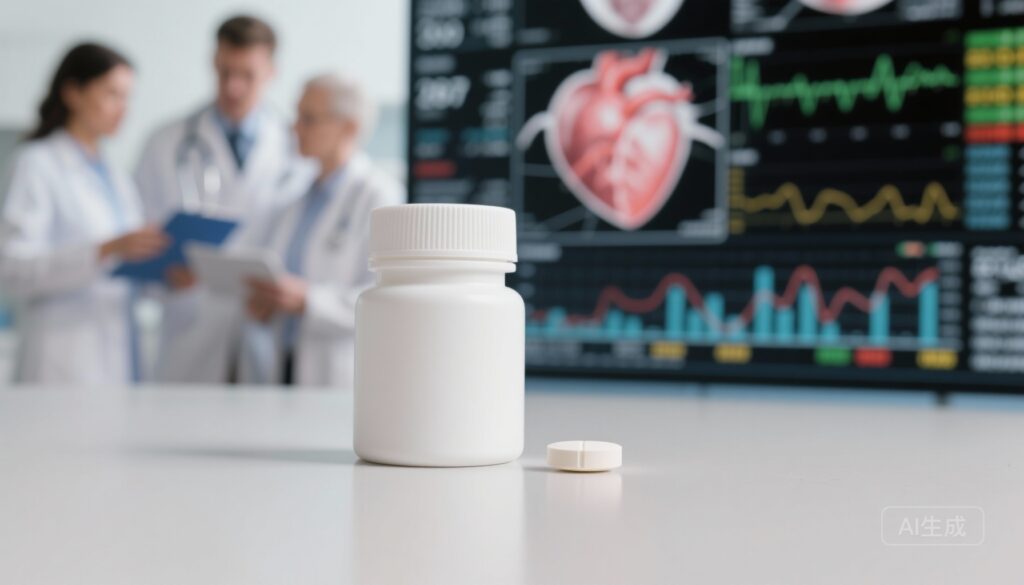Highlights
– Enlicitide decanoate, an oral PCSK9 inhibitor, produced a mean 58.2% reduction in LDL‑C at 24 weeks versus placebo in adults with heterozygous familial hypercholesterolemia (HeFH) on background statin therapy.
– Reductions were durable to 52 weeks (≈55% reduction), and non‑HDL‑C, apolipoprotein B, and lipoprotein(a) also fell significantly.
– Safety and tolerability were similar to placebo over 52 weeks; the trial was lipid‑end point driven and not powered for cardiovascular outcomes.
Background
Heterozygous familial hypercholesterolemia (HeFH) is an autosomal dominant disorder characterized by lifelong elevations in low‑density lipoprotein cholesterol (LDL‑C) and markedly increased atherosclerotic cardiovascular disease (ASCVD) risk. Despite statins, ezetimibe, and injectable PCSK9 monoclonal antibodies or siRNA therapies, many patients with HeFH fail to reach guideline LDL‑C targets, particularly those with very high baseline LDL‑C or established ASCVD. An effective oral PCSK9 inhibitor could improve access, adherence, and convenience for patients who require further LDL‑C lowering.
Study design
This phase 3, randomized, double‑blind, placebo‑controlled trial (NCT05952869) enrolled adults (≥18 years) with HeFH receiving lipid‑lowering therapy (≥moderate‑ or high‑intensity statins). Inclusion required either an LDL‑C ≥55 mg/dL with prior major ASCVD or LDL‑C ≥70 mg/dL without prior major ASCVD. Participants were randomized 2:1 to oral enlicitide decanoate 20 mg once daily (n = 202) or placebo (n = 101) for 52 weeks across 59 sites in 17 countries. The primary end point was mean percent change in LDL‑C at week 24. Secondary end points included LDL‑C change at week 52; changes in non‑HDL‑C, apolipoprotein B (apoB), and median change in lipoprotein(a) [Lp(a)] at week 24. Safety outcomes included adverse events (AEs), serious AEs (SAEs), and treatment discontinuations.
Key findings
Population: Of 303 randomized participants (mean age 52.4 years; 51% female), baseline mean LDL‑C was 119.0 mg/dL (SD 41.0 mg/dL). All participants were on statins (81.5% high‑intensity) and 64.4% were taking ezetimibe. Trial completion was high: 293/303 (96.7%) completed 52 weeks.
Primary efficacy (LDL‑C)
At week 24 the mean percent change in LDL‑C was −58.2% in the enlicitide group versus +2.6% in the placebo group. The between‑group difference was −59.4% (95% CI, −65.6% to −53.2%; P <.001). This magnitude of LDL‑C lowering is in the range observed with injectable PCSK9 monoclonal antibodies.
Durability to 52 weeks
At week 52 the mean percent change in LDL‑C was −55.3% with enlicitide vs +8.7% with placebo (between‑group difference −61.5%; 95% CI, −69.4% to −53.7%; P <.001), indicating sustained lipid lowering across one year.
Other lipid markers
At week 24 enlicitide significantly reduced non‑HDL‑C (mean −52.3% vs +2.1% with placebo; between‑group difference −53.0%; 95% CI, −58.5% to −47.4%; P <.001) and apoB (mean −48.2% vs +1.8%; between‑group difference −49.1%; 95% CI, −54.0% to −44.3%; P <.001). Median Lp(a) decreased by −24.7% with enlicitide compared with −1.6% with placebo (between‑group difference −27.5%; 95% CI, −34.3% to −20.6%; P <.001).
Safety and tolerability
The incidence of AEs, SAEs, and discontinuations due to AEs was similar between treatment groups over 52 weeks. The published summary reports no unexpected safety signals; however, detailed safety tables (specific AE categories, hepatic or muscular laboratory changes, and adjudicated events) should be consulted in the full publication for granular assessment.
Comparative context
Injectable PCSK9 monoclonal antibodies (e.g., evolocumab, alirocumab) demonstrated LDL‑C reductions of approximately 50–60% on top of standard therapy and reduced major cardiovascular events in large outcome trials (FOURIER, ODYSSEY OUTCOMES). The siRNA agent inclisiran produces durable LDL‑C reductions with twice‑yearly dosing and has also shown favorable lipid effects. The magnitude of LDL‑C lowering seen with oral enlicitide in this trial (≈55–58%) is comparable to these established agents, but enlicitide’s oral daily route would represent a paradigm shift in administration and potential adherence advantages if safety and long‑term outcomes are confirmed.
Expert commentary and interpretation
Strengths of this trial include randomized placebo control, high retention, clinically relevant HeFH population on contemporary background therapy, and a prespecified 52‑week follow‑up showing durability. The robust reductions in LDL‑C, non‑HDL‑C, apoB, and Lp(a) are biologically plausible for a PCSK9 inhibitor and clinically meaningful given the relationship between LDL‑C/apoB lowering and ASCVD risk reduction.
Key limitations temper immediate clinical adoption. This study was designed and powered for lipid end points rather than cardiovascular outcomes. Therefore, whether enlicitide reduces hard ASCVD events remains unknown. Safety surveillance beyond one year is needed to identify rare or delayed adverse effects. The trial enrolled only HeFH patients on background statin therapy; efficacy and safety in statin‑intolerant patients, in homozygous FH, and in broader primary prevention populations were not studied here. Finally, industry sponsorship and manufacturer pricing will influence access and comparative cost‑effectiveness, which are essential to real‑world implementation.
Mechanistic considerations
PCSK9 inhibition reduces circulating PCSK9 activity, increasing LDL receptor recycling and hepatic clearance of LDL particles. Enlicitide decanoate is described as an oral PCSK9 inhibitor — available data indicate it achieves substantial systemic PCSK9 inhibition sufficient to produce large LDL‑C and apoB reductions. The observed Lp(a) lowering is consistent with other PCSK9 inhibitors and may confer additional ASCVD risk reduction, although Lp(a) is less responsive to many conventional lipid‑lowering agents.
Clinical implications
For clinicians managing HeFH, enlicitide represents a promising oral therapeutic option to achieve target LDL‑C reductions when statin ± ezetimibe are insufficient or not tolerated. If confirmed in broader populations and longer follow‑up, oral administration may improve uptake over injectable therapies, facilitate outpatient prescribing, and reduce administration logistics. However, clinicians should await cardiovascular outcomes data, longer safety follow‑up, real‑world pharmacovigilance, and guideline incorporation before routine replacement of established PCSK9 monoclonal antibodies or inclisiran in indications where those agents have demonstrated outcome benefit.
Unanswered questions and next steps
– Does enlicitide reduce major adverse cardiovascular events (MACE) in primary and secondary prevention? Large, event‑driven outcome trials are needed.
– What is the long‑term safety profile beyond 1 year, including hepatic, muscular, neurocognitive, metabolic, immunologic, and cancer surveillance concerns?
– How will enlicitide perform in subgroups not studied here (statin‑intolerant patients, homozygous FH, pediatric populations)?
– Comparative effectiveness and cost‑benefit versus injectable PCSK9 monoclonal antibodies and inclisiran should be evaluated.
Conclusion
In this phase 3 randomized trial of adults with HeFH on background statin therapy, oral enlicitide decanoate 20 mg daily produced marked and durable reductions in LDL‑C (~58% at 24 weeks, ~55% at 52 weeks) and meaningful reductions in non‑HDL‑C, apoB, and Lp(a), with a safety profile comparable to placebo over one year. These results establish enlicitide as a highly effective oral lipid‑lowering agent in HeFH. However, cardiovascular outcome data, longer safety follow‑up, and broader population studies are required before enlicitide can be positioned as a standard therapy in routine clinical practice.
Funding and clinical trial registration
ClinicalTrials.gov Identifier: NCT05952869. Funding sources and conflicts of interest are reported in the original JAMA publication (Ballantyne et al., 2025) and should be consulted for a full disclosure.
References
1. Ballantyne CM, Gellis L, Tardif JC, et al. Efficacy and Safety of Oral PCSK9 Inhibitor Enlicitide in Adults With Heterozygous Familial Hypercholesterolemia: A Randomized Clinical Trial. JAMA. 2025 Nov 9. doi:10.1001/jama.2025.20620. PMID: 41206969.
2. Sabatine MS, Giugliano RP, Keech AC, et al.; FOURIER Steering Committee and Investigators. Evolocumab and Clinical Outcomes in Patients with Cardiovascular Disease. N Engl J Med. 2017 May 25;376(18):1713–1722.
3. Schwartz GG, Steg PG, Szarek M, et al.; ODYSSEY OUTCOMES Committees and Investigators. Alirocumab and Cardiovascular Outcomes after Acute Coronary Syndrome. N Engl J Med. 2018 Nov 22;379(22):2097–2107.
4. Ray KK, Wright RS, Kallend D, et al.; ORION‑9 Investigators. Inclisiran in Patients with Heterozygous Familial Hypercholesterolemia. N Engl J Med. 2020;382:1520–1530.
5. Mach F, Baigent C, Catapano AL, et al. 2019 ESC/EAS Guidelines for the management of dyslipidaemias: lipid modification to reduce cardiovascular risk. Eur Heart J. 2020 Jan 1;41(1):111–188.
6. Nordestgaard BG, Chapman MJ, Humphries SE, et al. Familial hypercholesterolaemia is underdiagnosed and undertreated in the general population: guidance for clinicians to prevent coronary heart disease. Eur Heart J. 2013;34(45):3478–3490.
AI thumbnail prompt
A high‑resolution, clinical stock image: a modern white round tablet in front of a blurred cardiology clinic environment. In soft focus, clinicians review a lipid panel on a tablet and a wall display shows simplified LDL‑C graphs. The mood is hopeful and professional; neutral blues and grays; studio lighting; photorealistic.



